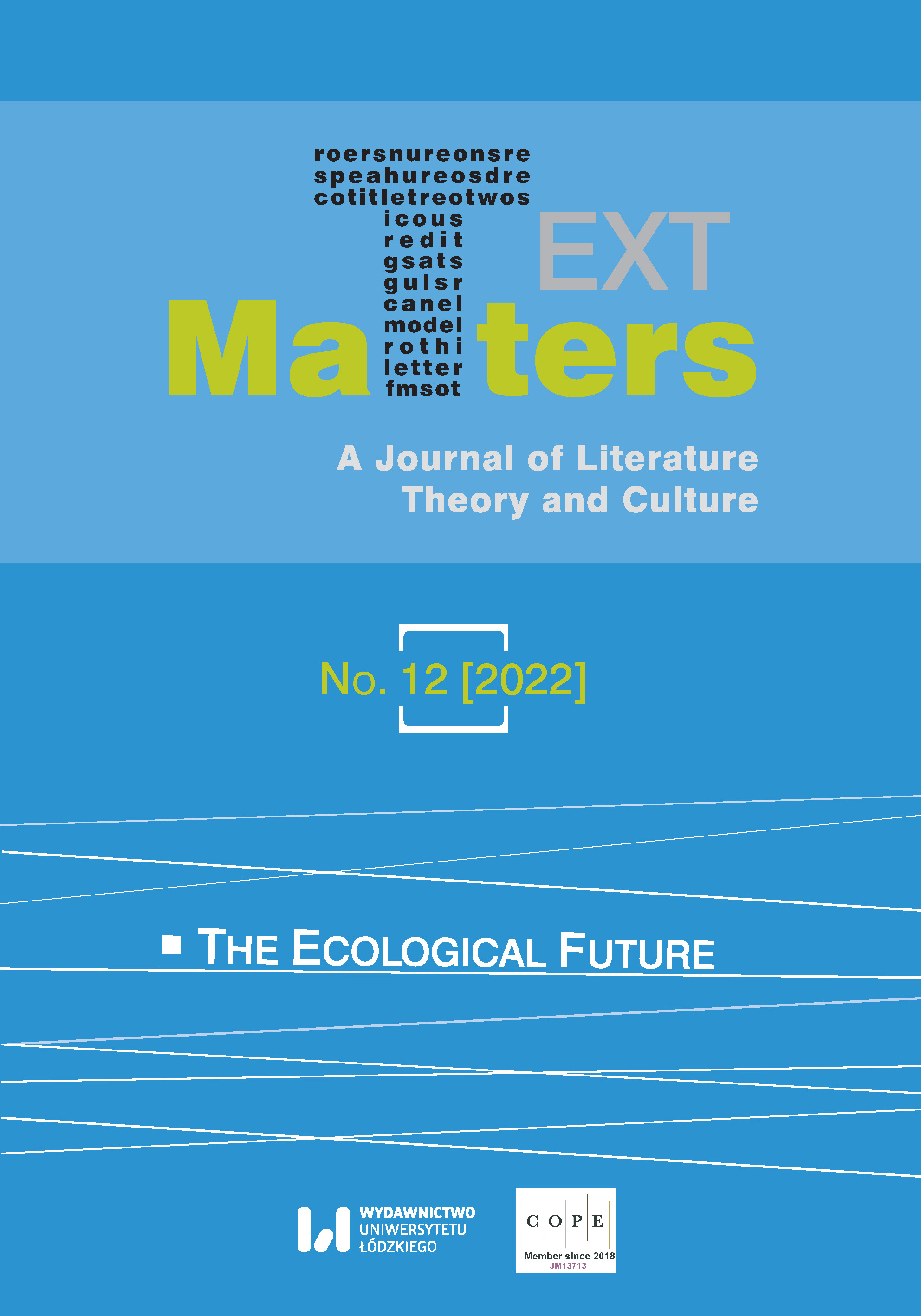Comics in the Anthropocene: Graphic Narratives of Apocalypse, Regeneration and Warning
DOI:
https://doi.org/10.18778/2083-2931.12.03Keywords:
comics, graphic novels, Anthropocene, temporality, apocalypseAbstract
Narratives of the Anthropocene function in the realm of not only scientific but also popular discourses. Indeed, the most popular narratives of the Anthropocene, namely the story of the apocalypse and the story of progress, with their respective temporalities, are particularly well-represented in comics. The present article looks at the Anthropocene through the lenses of word and image, tracing the response of the medium of comics to the ongoing catastrophe, including Joe Sacco’s Paying the Land (2020), Scott Snyder and Yanick Paquette’s modern take on Swamp Thing (2019) and Richard McGuire’s Here (2014). Paying the Land is a story of the Dene people and their response to the Anthropocene. Drawing on the opposition between nature and progress, it examines whether empathy can stop capitalistic exploitation of Indigenous communities and the land which they cherish. Swamp Thing, seemingly a narrative of environmental apocalypse, also functions as a story of ecological reconciliation and regeneration. Finally, Here builds on and deconstructs the narrative of progress, demonstrating how a specific location has and will be transformed from 3,000,500,000 BCE to 22,175 CE, offering the reader/viewer a non-chronological look at environmental changes. Apart from the visions of the now and the future that these graphic narratives present, temporality coded in their “grammar” (layout, panels and gutters) is also discussed.
Downloads
References
Bakhtin, Mikhail. “Forms of Time and of the Chronotope in the Novel.” The Dialogic Imagination, translated by Caryl Emerson and Michael Holquist, U of Texas P, 1981, pp. 84–258.
Google Scholar
Chakrabarty, Dipesh. “Anthropocene Time.” History and Theory, vol. 57, no. 1, 2018, pp. 5–32. https://doi.org/10.1111/hith.12044
Google Scholar
DOI: https://doi.org/10.1111/hith.12044
Chute, Hillary. Disaster Drawn: Visual Witness, Comics, and Documentary Form. Belknap P of Harvard UP, 2016. https://doi.org/10.4159/9780674495647
Google Scholar
DOI: https://doi.org/10.4159/9780674495647
Chute, Hillary, and Marianne DeKoven. “Introduction: Graphic Narrative.” MFS Modern Fiction Studies, vol. 52, no. 4, 2006, pp. 767–82. https://doi.org/10.1353/mfs.2007.0002
Google Scholar
DOI: https://doi.org/10.1353/mfs.2007.0002
Clark, Timothy. Ecocriticism on the Edge: The Anthropocene as a Threshold Concept. Bloomsbury Academic, 2015.
Google Scholar
De Cristofaro, Diletta. The Contemporary Post-Apocalyptic Novel: Critical Temporalities and the End Times. Bloomsbury, 2020. https://doi.org/10.5040/9781350085800
Google Scholar
DOI: https://doi.org/10.5040/9781350085800
Dong, Lan. “Inside and Outside the Frame: Joe Sacco’s Safe Area Goražde.” The Comics of Joe Sacco: Journalism in a Visual World, edited by Daniel Worden, UP of Mississippi, 2015, pp. 39–53. https://doi.org/10.14325/mississippi/9781496802217.003.0003
Google Scholar
DOI: https://doi.org/10.2307/j.ctt15zc587.6
Earle, Harriet. Comics, Trauma, and the New Art of War. UP of Mississippi, 2017. https://doi.org/10.14325/mississippi/9781496812469.001.0001
Google Scholar
DOI: https://doi.org/10.14325/mississippi/9781496812469.001.0001
Farrier, David. Anthropocene Poetics: Deep Time, Sacrifice Zones, and Extinction. U of Minnesota P, 2019. https://doi.org/10.5749/j.ctvc5pcn9
Google Scholar
DOI: https://doi.org/10.5749/j.ctvc5pcn9
Jones, Owain, Kate Rigby, and Linda Williams. “Everyday Ecocide, Toxic Dwelling, and the Inability to Mourn: A Response to Geographies of Extinction.” Environmental Humanities, vol. 12, no. 1, 2020, pp. 387–405. https://doi.org/10.1215/22011919-8142418
Google Scholar
DOI: https://doi.org/10.1215/22011919-8142418
Klassen, Chris. “Embodiment through Comics.” The Bloomsbury Handbook of the Cultural and Cognitive Aesthetics of Religion, edited by Anne Koch and Katharina Wilkens, Bloomsbury, 2019, pp. 165–74. https://doi.org/10.5040/9781350066748.ch-015
Google Scholar
DOI: https://doi.org/10.5040/9781350066748.ch-015
McCloud, Scott. Understanding Comics: The Invisible Art. William Morrow, 1993.
Google Scholar
McGuire, Richard. Here. Pantheon, 2014.
Google Scholar
McGuire, Richard. Tutaj. Wydawnictwo Komiksowe, 2016.
Google Scholar
Nixon, Rob. Slow Violence and the Environmentalism of the Poor. Harvard UP, 2011. https://doi.org/10.4159/harvard.9780674061194
Google Scholar
DOI: https://doi.org/10.4159/harvard.9780674061194
Petersen, Robert S. Comics, Manga, and Graphic Novels: A History of Graphic Narratives. ABC-CLIO, 2001.
Google Scholar
Robin, Libby. “The View from Off-Centre: Sweden and Australia in the Imaginative Discourse of the Anthropocene.” Nature, Temporality and Environmental Management: Scandinavian and Australian Perspectives on Peoples and Landscapes, edited by Lesley Head et al., Routledge, 2016, pp. 59–74. https://doi.org/10.4324/9781315597591-5
Google Scholar
DOI: https://doi.org/10.4324/9781315597591-5
Sacco, Joe. Paying the Land. Jonathan Cape, 2020.
Google Scholar
Sacco, Joe. The Great War: July 1, 1916: The First Day of the Battle of the Somme. Jonathan Cape, 2013.
Google Scholar
Snyder, Scott, and Yanick Paquette. Swamp Thing: Protector of the Green. DC Comics, 2019.
Google Scholar
Sobelle, Stefanie. “Rhyming Times: The Architecture of Progressive Time and Simultaneity in Richard McGuire’s Here.” Writing about Time: Essays on American Literature, edited by Cindy Weinstein, Cambridge UP, 2019, pp. 206–25. https://doi.org/10.1017/9781108525510.012
Google Scholar
DOI: https://doi.org/10.1017/9781108525510.012
Sousanis, Nick. Unflattening. Harvard UP, 2015.
Google Scholar
Swyngedouw, Erik. “Apocalypse Forever? Post-political Populism and the Spectre of Climate Change.” Theory, Culture & Society, vol. 27, no. 2–3, 2010, pp. 213–32. https://doi.org/10.1177/0263276409358728
Google Scholar
DOI: https://doi.org/10.1177/0263276409358728
Tuan, Yi-Fu. “Space and Place: Humanistic Perspective.” Philosophy in Geography, edited by Stephen Gale and Gunnar Olsson, Reidel, 1979, pp. 387–427. https://doi.org/10.1007/978-94-009-9394-5_19
Google Scholar
DOI: https://doi.org/10.1007/978-94-009-9394-5_19
Zalasiewicz, Jan. “The Extraordinary Strata of the Anthropocene.” Nature and Value, edited by Akeel Bilgrami, Columbia UP, 2020, pp. 29–45. https://doi.org/10.7312/bilg19462-006
Google Scholar
DOI: https://doi.org/10.7312/bilg19462-006
Zalasiewicz, Jan, et al. “The Anthropocene: Comparing Its Meaning in Geology (Chronostratigraphy) with Conceptual Approaches Arising in Other Disciplines.” Earth’s Future, vol. 9, 2021. https://doi.org/10.1029/2020EF001896
Google Scholar
DOI: https://doi.org/10.1029/2020EF001896
Published
How to Cite
Issue
Section
License

This work is licensed under a Creative Commons Attribution-NonCommercial-NoDerivatives 4.0 International License.













